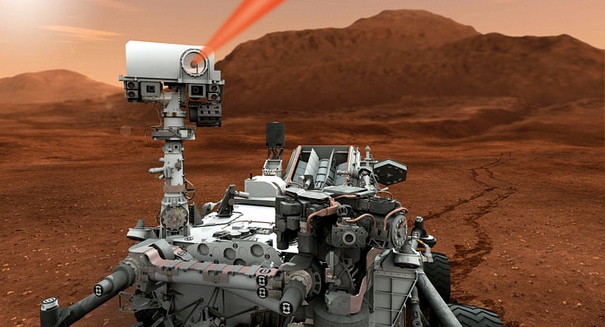
Curiosity's study of Mars soil has offered new details about the local, regional and worldwide processes taking place on the Red Planet.
According to a news release from NASA, a scoop of Mars soil is two percent water.
The latest discovery is just one of Curiosity rover’s fantastic findings on the Red Planet. Since landing on the Martian surface last August, Curiosity has told scientists a lot about Mars, offering details about ancient processes in the Red Planet’s interior as well as information about the interplay between the Martian surface and atmosphere.
Curiosity’s study of Mars soil has offered new details about the local, regional and worldwide processes taking place on the Red Planet. In a recent edition of the journal Science, examination of observations and measurements by Curiosity’s science instruments during the first several months after its landing are described.
An important discovery is that water molecules account for approximately two percent of the soil particles’ weight at Gale Crater where Curiosity first touched down. The findings have significant ramifications, because these soil particles are probably dispersed around Mars.
Curiosity also has finished the first detailed mineralogical analysis on another planet utilizing a standard laboratory technique for determining minerals on Earth. The discoveries about both crystalline and non-crystalline parts in soil offer hints about the Red Planet’s volcanic history.
Details about the development of the Mars crust and deeper regions within the Red Planet originates from the rover’s mineralogical study of a football-size igneous rock known as “Jake M.” The chemical makeups of igneous rocks can be utilized to determine the thermal, pressure and chemical environments under which they crystallized.
“No other Martian rock is so similar to terrestrial igneous rocks,” said Edward Stolper of the California Institute of Technology. “This is surprising because previously studied igneous rocks from Mars differ substantially from terrestrial rocks and from Jake M.”
Curiosity also explored a drift of sand and dust, known as Rocknest, with five scientific instruments, conducting an onboard laboratory study of samples obtained from the Red Planet. The drift has an intricate history and contains sand particles with local ancestry, as well as finer particles that model windblown Mars dust dispersed regionally or even globally.
Curiosity’s laser instrument, which is designed to determine material makeups from some distance away, discovered that the fine-particle component in the Rocknest drift matches the makeup of windblown dust and holds water molecules. Curiosity examined 139 soil targets during the mission’s first three months and detected hydrogen every time its laser hit fine-particle material.
“The fine-grain component of the soil has a similar composition to the dust distributed all around Mars, and now we know more about its hydration and composition than ever before,” said Pierre-Yves Meslin of the Institut de Recherche en Astrophysique et Planétologie.
X-ray analysis inside Curiosity determined the makeup of Rocknest samples. The X-rays analysis identified 10 distinct minerals and discovered that a large portion of the Rocknest composition is amorphous ingredients, as opposed to crystalline minerals. Amorphous ingredients are a component of some volcanic deposits on our planet.

Another scientific instrument determined chemicals and isotopes in gases discharged by heating the Rocknest soil in a small oven. These tests discovered that water comprises two percent of the soil, and that the water molecules are bound to the amorphous ingredients in the soil.
“The ratio of hydrogen isotopes in water released from baked samples of Rocknest soil indicates the water molecules attached to soil particles come from interaction with the modern atmosphere,” said Laurie Leshin of Rensselaer Polytechnic Institute.
Curiosity also found a Rocknest sample containing a compound with chlorine and oxygen, which was previously thought to exist on the Red Planet only at one high-latitude location.
According to NASA, data from the rover’s first several months on Mars continue to be studied.
Leave a Reply